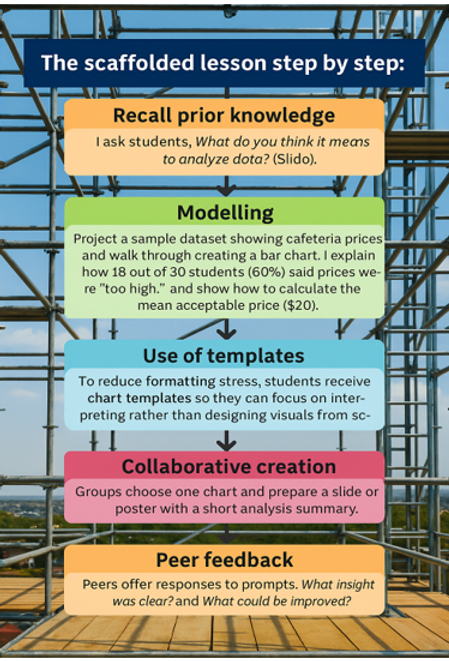Scaffolding

What is Scaffolding?
The first thing that came to my mind were tall iron frames construction workers use when they are building or painting a tall structure. I pictured metal rods stacked up; to help reach a height they couldn’t on their own. I wasn’t too far off I just needed to link the concept to teaching.
After listening to a lecture on instructional scaffolding, I realized that in education, scaffolding works the same way. It’s the support teachers give to help students reach learning goals they would not be able to accomplish on their own. Van de Pol, Volman, and Beishuizen (2010) describe it as “contingent support” temporary assistance tailored to a student’s current level of understanding, gradually withdrawn as the learner becomes more capable and independent.
That construction image made me realize just like every level of scaffolding must be stable and connected, in the classroom, every learning step must also be clear, intentional, and linked to the next. Scaffolding is thoughtfully planning how to build understanding from one stage to the next using engaging, well matched instructional strategies.
COMPONENTS OF SCAFFOLDING (Lesson 6 – Analysing and Presenting Results)
In this lesson, scaffolding was applied through a structured sequence that moved from teacher-led support to student-driven application using the following components:
1) Activating Prior Knowledge: Students will respond to “What do you think it means to analyse data?” using Slido. This will help surface existing ideas and created a bridge between familiar and new content.
2) Modelling: I will guide students through analysing a sample dataset, showing how to calculate the mean, interpret percentages, and select suitable charts. This explicit demonstration will provide a foundation before students apply the skill themselves.
3) Guided Practice: Students will analyse their own survey results in groups while I prompt and questioned them. Prompting is an important component of scaffolding, as it guides students to think independently. This phase supports thinking without giving direct answers, encouraging
learners to develop confidence.
4) Use of Visual Templates: By removing formatting stress through pre-made chart templates, students could focus on the higher-order task of interpreting and summarizing data. This will ease the cognitive load while reinforcing structure of the particular lesson.
5) Collaborative Work: Working in groups to create analysis visuals will give students a chance to rehearse their understanding with peer support, another form of temporary scaffold.
6) Peer Feedback: Constructive prompts will guide students to assess clarity and relevance in each other’s work, fostering evaluative thinking and help them to understand success criteria.
7) Reflection and Independence: After presenting, students will reflect on ethical issues in business data presentation. With support intentionally faded from the teacher, students will demonstrate ownership of learning and critical thinking.
Each scaffold component was intentionally selected to help students understand the skill of analysing and presenting data, a key outcome in the Marketing Research Unit. Scaffolding was chosen as it supports students in moving from raw data to meaningful analysis through a structured, step-by-step approach. It also allowed the lesson to remain student-centered and engaging by giving students a hands-on opportunity to work with their own findings. Through modelling, guided practice, peer feedback, and ethical reflection, students developed both technical and evaluative skills while gradually taking more responsibility for their learning. This approach aligned not only with the topic, but also with my goal of creating real-world and reflective learning experiences for the Form 6 students, who will be soon entering the world of work.
The flowchart below shows a logical sequencing of scaffolded support in the Analysis and Presentation Lesson: it begins with activating prior knowledge, followed by modelling and guided practice, then moves into collaborative creation and feedback, and ends with reflection. This structure illustrates the gradual release of responsibility, highlighting how instructional scaffolding supports student growth from supported learning to confident application.

